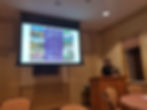Uncomfortable Conversations in a Peaceful Place
- Cat Meholic
- Nov 6, 2018
- 4 min read
Updated: Nov 8, 2018
Last month, Women in Horticulture participated in a critical thinking workshop at Mt. Cuba Center. The content was created by Kathy Salisbury, Director of the Ambler Arboretum of Temple University. I hope this summary helps capture the day.
What if you met someone who waxed poetic about their beautiful hedge of burning bush (Euonymus alatus)? What if they said they don't believe climate change could possibly be caused by humans? I know my first instinct would be to prepare my best monologue telling that person just how wrong they are about everything.
But, is that the best way to engage someone with a different opinion?
Kathy Salisbury would tell us that a different strategy might be more successful to truly move a conversation forward. Kathy's background is in adult education and lifelong learning, which also happens to be the focus of the Doctorate of Education she's pursuing through Penn State while directing the Ambler Arboretum. As someone who cares deeply about social justice issues, she prides herself on being a "pot-stirrer." From my meetings with Kathy, I would call her the gentlest pot-stirrer that I have ever met. She coaxes your mind to stretch and consider the other side of an argument. It's a subtle process, but she was able to lead a room full of Women in Horticulture through it during our workshop.

After a standard introduction to her role at Temple and the context of Ambler Arboretum within America's Garden Capital, Kathy lead us through an unusual personal introduction. She quickly listed off key characteristics of her life that shape who she is and where she comes from. This included where she was born, how many siblings she has, her parents' marital status, her financial class, education, and even some of her biases.

She then asked us to introduce ourselves using the same model. It was difficult to sum up my existence in a few quick sentences, but it made me question how I normally introduce myself and if it truly "sums me up." Given this model, how would you introduce yourself to capture all of your ethics, biases, background, and family influences? It's difficult.
Next Kathy listed her assumptions of the audience: we are horticulturists, we enjoy being outside, we are well-educated, we identify as women, etc. When I engage with people now, I catch myself thinking of Kathy and asking myself, "What are my assumptions about these people? Are they fair? Are they accurate?" It turns out that acknowledging assumptions is one part of the process towards engaging in more meaningful conversations.

From there we broke out into group discussions. Each table had a set of cards with topics on one side. These topics ranged from "lawns and lawn care" to "immigrant labor" and "large agriculture chemical companies." Our mission was to discuss each topic as a group, understand individual opinions about each, and then explore what other perspectives might not be represented at the table.
We took a brief break before jumping back in to round two of strengthening our critical thinking. Kathy defined what critical thinking actually means, and that one way to define it is "the art and evaluation of thought in order to create change." With this definition in hand, we began dissecting the process of critically thinking while in conversation with others. The steps include: checking perceptions, acknowledging assumptions, listening with intent, and confirming with the speaker that you understand what they are trying to communicate. A key perception check to observe is body language. Is the speaker leaning in? Are their arms wrapped around themselves? Do they maintain eye contact? Humans subconsciously are very good at picking up these cues, but mindfully analyzing these cues helps you better connect with the speaker.

Next we were challenged to go back to our tables and work with the discussion cards again. This time, however, we were given a new style of card, called a "wrench." The wrench cards provided us with perspectives to consider when making judgments on our topic cards. In addition to practicing our active listening skills, we also had to consider the perspectives on the wrench cards in our dialogue. It was a difficult exercise, even with active listening cues to guide us, like "What I understand you saying is..." or "Is this true that...?"
Kathy had one final exercise to challenge us. She posted the picture below: a monarch butterfly feeding on a purple loosestrife plant. She asked what our thoughts were about the image, and then had us role play with her for a bit. She played the homeowner, enamored with this great plant that she received as a gift from her daughter, and thrilled by how it supported an endangered species - the monarch! Everyone in the room knew purple loosestrife as an invasive species. How then does one gently explain that to someone so emotionally connected to this pesky plant? How do we describe that there are better plants to support monarchs? But, most importantly and in Kathy's words, "Does this need to be said? And does this need to be said by me now?"

I hope that this summary of Kathy's workshop encourages you to analyze your own thinking and to listen with intention. This was one of the most powerful workshops I have participated in, and the skill set practiced here goes well beyond horticulture. If you have the opportunity to attend one of Kathy Salisbury's workshops, I strongly recommend it!
One final thought from Kathy to consider: We should not approach conversations with other people aiming to change their mind. Rather, we should approach our interactions with the hope of "coming to an agreement from our differing perspectives."

Thanks again to Kathy Salisbury for creating the content for this event. Thanks also to our host Mt. Cuba Center for providing a beautiful meeting space and admissions to the garden for the day!





